Since we first introduced the Caribou Gear Hunter’s Tarp, we’ve enjoyed receiving customer photos from a wide range of hunting adventures. And we’ve been thrilled to hear the overwhelmingly positive feedback.
In case you aren’t familiar with the Hunter’s Tarp, here’s an updated, in-depth look at what has become one of our most popular products for hunters. We’ll cover the tarp’s purpose and intent; why construction and materials are so important; and how we use the tarp on our own western hunting trips….

Why We Created the Hunter’s Tarp
When loading our backpacks for a western hunt, we’re always looking for gear that’s lighter, more durable and that serves a tangible purpose. Even better, is any gear item that serves more than one purpose.
For years, we’ve been looking for a way to carry a tarp in the field on backcountry hunts. Most tarps are either too heavy to realistically carry in a daypack. Or they weren’t tough enough to withstand the jobs we needed them to do. Most tarps also lacked the features we needed to make them functional as a multi-purpose item. So, we set out to design one.
Spoiler alert: we ended up with a highly functional tarp for hunters. It weighs a mere 4.3 ounces. It’s totally waterproof. And it meets more than one need in the field. It has become a must-have piece of gear that we carry on every single hunt.

Photo courtesy of Mike Hill, @hillsandhighwater
Construction and Materials
The Hunter’s Tarp works because it’s built with the best possible materials and construction techniques. We started with a lightweight, rip-stop nylon material as the foundation for our tarp. After a great deal of research and testing, we found a material that met both our durability and weight objectives – two factors that are often at odds.
Next, we set out to determine the best waterproof coating. Many other field tarps use a cheap PVC coating. PVC is inexpensive and waterproof. But it lacks durability, and it adds significant bulk and weight. This clearly wouldn’t do.
We knew that our tarp had to be lightweight and completely waterproof. Even more than that, it had to withstand the heavy weight of an elk or moose quarter. It was important to us that blood wouldn’t soak through, even under these heavy pack loads. In the end, we landed on a double coating of silpolyU™ on both sides of the tarp – four total layers of waterproof protection.
We knew this type of construction wouldn’t be cheap. But it provided the performance and lightweight design that we would be confident using on our own hunts. Therefore, we opted not to cut any corners.
We’re happy to report that the Hunter’s Tarp performs exactly as designed. The Caribou Gear team and our customers have put the Hunter’s Tarp to the test on hunts for caribou, moose, sheep, elk, and so many more. The years of research, prototypes and testing have certainly paid off. And we’re proud to have constructed a purpose-built tarp for backcountry hunters.

Design Features
In addition to the materials and construction elements, there were a number of specific design features that we wanted to see on a tarp for hunters. First, we wanted durable stake loops in convenient locations. This would allow us to stake out the tarp for processing or deboning an animal in the field. Stake loops would also allow us to pitch the tarp as a field shelter for glassing or stormy weather.
When you use the Hunter’s Tarp, you’ll notice that the stake loops have long extensions. These were designed for use on snow or in tall grass. The long stake loop prevents the corners of the tarp from diving down, creating more flat, working surface.
We discovered that these loops should also be light reflective. When hanging the tarp over a cache of meat for shade or weather protection, reflective loops would allow us to find the meat by headlamp when we returned in the dark for a second load.
Since the stake loops are an important part of the tarp’s function, we decided to include four lightweight aluminum ground stakes. We’ve discovered that on our own hunts, the first thing we do when we harvest an animal is to stake the tarp out on the ground. If there’s snow or mud, this provides a place to set our rifle, jacket and backpack. Then as we quarter the animal, the tarp provides a clean surface to place meat and game bags.
Next, we wanted to include a waterproof stuff sack. This had to be ultra lightweight, not adding any significant weight to the total package. But when putting the tarp away after use, a waterproof stuff sack would ensure that neither rainwater nor blood would get inside the hunter’s backpack.
We were able to add the four stakes and the stuff sack without adding undue weight to the complete package. All together, it weighs just 5.6 ounces. It disappears in your pack and is an absolutely minuscule price to pay for the number of jobs it can perform.

Photo courtesy of Mike Hill, @hillsandhighwater
The Final Design
When it’s all said and done, the Caribou Gear Hunter’s Tarp has lived up to our expectations – and our customer reviews have been phenomenal. The tarp alone weighs only 4.3 ounces. With the waterproof stuff sack and four ground stakes, the entire packed weight is only 5.6 ounces. It provides a clean surface for quartering an animal or deboning meat. It’s an effective liner to keep blood off your backpack during the packout. And it serves as a useful glassing shelter or impromptu storm shelter.
The tarp is 5-feet by 4-feet, perfectly walking that line between lightweight design and functional use in the field. It’s large enough to make a suitable glassing shelter and enough space for quartering an elk – yet small enough to minimize space and weight in your backpack. When folded in its stuff sack, the dimensions are 4 inches by 4.5 inches.

How to Use the Hunter’s Tarp
As we mentioned above, the first thing we do when we arrive at a kill site is to stake the tarp out on the ground. Give yourself a clean surface before you begin quartering the animal. As you remove quarters from the animal, place them immediately into game bags and then lay them on the tarp to stay clean and dry. If you’re deboning meat for the packout, lay the quarters directly on the tarp – there you can debone them and place the loose meat into game bags.
If you find yourself working on a steep slope, remove the stakes on the downhill side of the tarp and re-stake the corners halfway up the tarp. This creates a pocket that will prevent quarters and game bags from sliding off.
Once you’re ready to haul meat, the Hunter’s Tarp can be used as a backpack liner. Whether your backpack has a meat shelf or if you’re placing quarters inside the pack bag, swaddle each load of meat in the tarp. With four total layers of silpolyU™ coatings, blood won’t soak through the game bags even under this heavy weight.
If you’re hanging the game bags from a meat pole at camp or in a tree during transport, use the Hunter’s Tarp to shade the meat and to keep it dry from rain or snow. Suspend the tarp above the meat so that it doesn’t inhibit air circulation. Keeping your meat cool, shaded and dry is an important part of meat care in the field.
Finally, the Hunter’s Tarp can be pitched using trekking poles or a tree branch along with guy lines and the included stakes. This makes an ideal shelter when glassing for long periods in the sun or when waiting out a mountain storm. The ultra waterproof design will help keep you comfortable and dry.

Photo courtesy of Mike Hill, @hillsandhighwater
Contact Us
We currently have the Caribou Gear Hunter’s Tarp in stock and ready to ship. It’s available in green or high-vis orange. Or, you can save when you order both colors together.
We offer fast, free shipping. Check out the Hunter’s Tarps here on the website. In addition to the Hunter’s Tarp, make sure you have game bags and other essentials for this hunting season!
When you have an opportunity to use the Hunter’s Tarp, please send us your feedback and photos. We’d love to see it in action and hear your feedback on its performance. Best of luck and have fun on all of your upcoming hunting adventures!

By Ryan McSparran








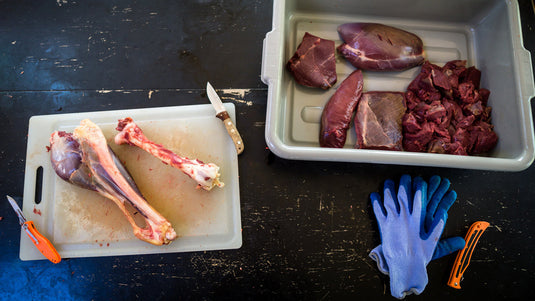
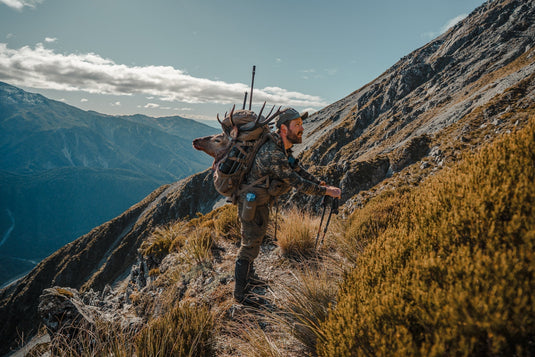
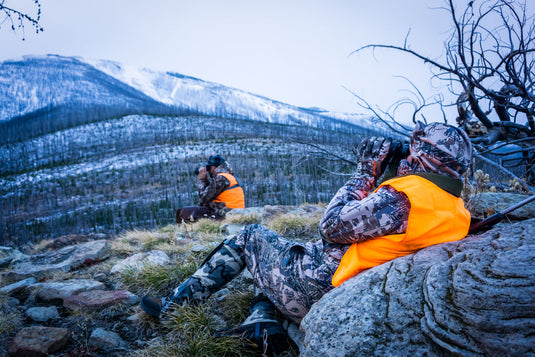
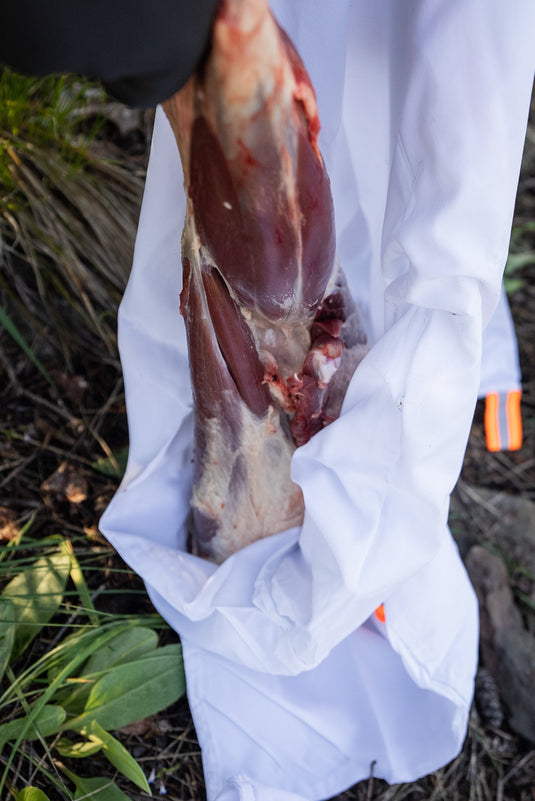
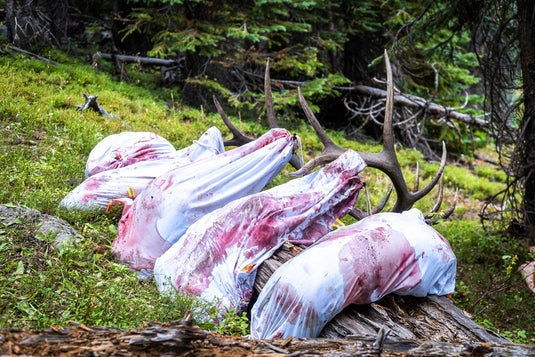
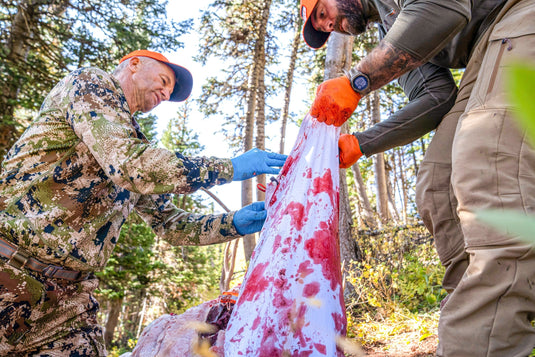
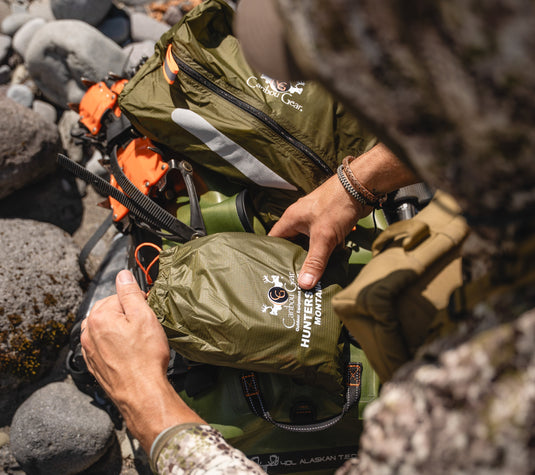
I’ve used your meat bags on Elk twice and hands down, worth every penny. When I saw the tarp advertised, it made perfect sense. Very multipurpose is what caught my eye. My son had an Elk tag in New Mexico this year. Knowing the quality of Caribou Gear equipment, I purchased the tarp. It sure came in handy. Will never hunt again without it. Thanks for a great common sense quality product.